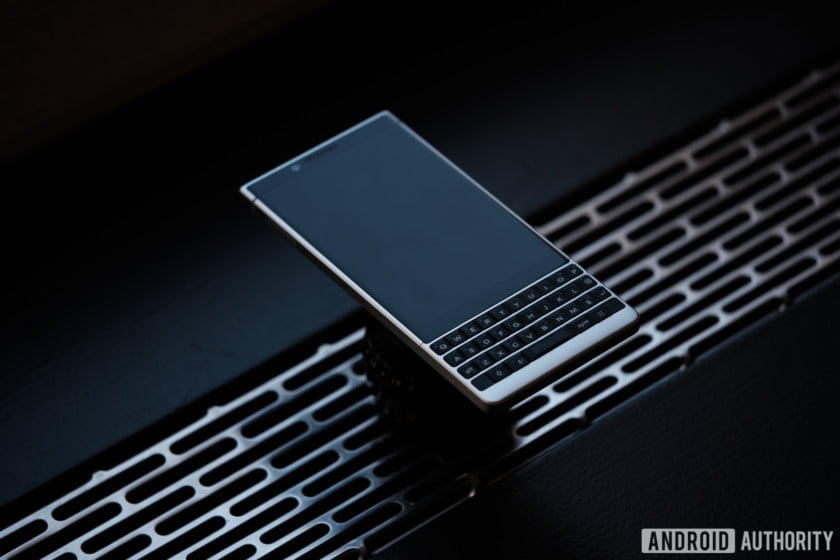
Blackberry isn’t the iconic smartphone brand it once was, now relegated to a niche position.
Over the last couple years it’s dramatically changed the way it does business. Blackberry Limited still owns the brand, but it no longer builds hardware, licensing out its name to partners TCL and India-based Optiemus Infracom.
Today’s Blackberry phones are designed, manufactured, and marketed by those partners. Blackberry Limited merely focuses on creating software and security updates for Blackberry branded devices.
However, despite its smaller role in the mobile world, 2018 was still a great year.
TCL followed the successful 2017 Blackberry KeyOne with the Key2 and Key 2 LE, which gained significant traction for the brand. Meanwhile, newcomer Optiemus Infracom helped the brand expand into India with the Evolve and Evolve X.
The whole year felt like a move in the right direction, but there’s still a long road ahead.
Blackberry in 2018: more devices, more markets

The KeyOne was the beginning of a new direction.
Blackberry’s road to recovery began with the Blackberry KeyOne in 2017. Designed by Blackberry but built by then-new partner TCL, the KeyOne was a breath of fresh air in a market where every phone looked and felt the same. It not only looked dramatically different, thanks to its physical keyboard, but it also felt heftier and more durable than most modern smartphones. Nostalgia also played a role in its success.
Hoping to continue the groundwork laid by the KeyOne, TCL struck again with the announcement of the Blackberry Key2 in June of 2018.
The Blackberry Key2 didn’t reinvent the wheel, focusing more on refinement. It had bigger and better-feeling physical keys, an improved camera, and a much more modern design than its predecessor. Its hardware also performed significantly better than the KeyOne thanks to an upgraded Snapdragon 660and double the RAM at 6GB.
As Jimmy Westenberg noted in our review, the only real downside was the price.

At $650, the Blackberry Key2 was one of the most expensive mid-range phones around — $100 more expensive than its predecessor. While companies like OnePlus offered the latest Qualcomm processors for noticeably less money, TCL asked quite a premium for relatively modest specs.
In fairness, the price wasn’t so shocking. Adding a physical keyboard wasn’t cheap, especially since other OEMs didn’t use them. Production yields were smaller, and development costs were higher. The inclusion of a convenience key also didn’t help keep the cost down.
The Key2 took everything we loved from the KeyOne but improved on what we didn’t.
Anyone who has ever used a Key2 will probably agree it’s just “another ordinary smartphone” without both of these things, so there’s probably not a whole lot TCL could have down to keep pricing lower on the Key2. However, regardless of reason, the Key2’s price was a roadblock for some buyers.
Hoping to appeal to those with reservations, TCL introduced the Blackberry Key2 LE in August.

Sporting a keyboard and similar looks to the Key2, the LE downgraded horsepower, battery life, and camera quality in order to bring the cost down to a much more reasonable $399. Performance wise, the Key2 LE slotted between the retired KeyOne and the flagship Key2.
The LE was a home run for TCL. At CES 2019 TCL confirmed the Key2 family had significantly outsold the KeyOne, and the Blackberry Key2 LE played a large part in this.
TCL acknowledged the Key2 sold at least on the same level with the KeyOne, but the LE’s lower price made it a more compelling option for enterprise buyers and general consumers. Blackberry also admitted that the phone’s more colorful design helped the device better appeal towards women and younger audiences.
The TCL-made Key2 family was Blackberry’s only global offering, but new partner Optiemus Infracom also produced two phones of its own using the Blackberry brand name. Available exclusively in India, the Evolve and Evolve X arrived in the latter half of 2018.
Unlike TCL’s models, the Evolve family ditched the physical keyboard and launched with relatively low end specs. Though not as expensive as the Key2, these devices weren’t particularly low cost at 24,990 rupees (~$364) for the Evolve and 34,990 rupees (~$509) for the Evolve X.
Blackberry in 2018: the slow road to rebuilding a legacy
We don’t have hard data on Blackberry sales for 2018, as Blackberry and its partners haven’t been exactly forthcoming. Still, it’s safe to say sales were probably a fraction of bigger brands like Huawei and Samsung.
Regardless, TCL is very pleased with how its Blackberry phones have fared. The company knew it would be an uphill battle when it signed on.
In 2017 Blackberry had mostly faded out of the public eye. Phones with physical keyboards were all but dead, and most manufacturers believed there was no longer a market for it.
Selling a phone with an arguably obsolete keyboard and an identity crisis was never going to be easy but somehow Blackberry has slowly turned things around.
To make matters worse, TCL’s own consumer surveys indicated consumers were deeply confused about Blackberry’s identity. Only 20 percent even realized Blackberry phones now run on Android. The problem was Blackberry phones were strongly associated with the aging Blackberry OS, which was known for its lack of apps.
Selling a phone with an arguably obsolete keyboard and an identity crisis was never going to be easy. Yet a year later, TCL’s 2018 consumer surveys indicated now more than 80 percent of consumers knew that Blackberry no longer used BBOS.
In a little over two years, TCL managed to slowly win over a small fanbase in consumer and enterprise segments. It also overcame some of the brand confusion in the process, thanks to marketing and the passage of time. This isn’t Apple-levels of success, but it’s a great start.
What’s next for Blackberry as a smartphone brand?

Blackberry probably won’t ever get back to its former rockstar status, but there’s still reason to be optimistic.
Later this year we can almost certainly expect TCL to unveil the Key2’s successor. There aren’t any real rumors about the phone, but it’s pretty likely we’ll see continued refinement, rather than major evolution. The real ace up TCL’s sleeve won’t be hardware or software features, but timing.
When the Key2 first came out it was fighting against the fact most users who wanted a physical keyboardalready had the Blackberry KeyOne. Considering many U.S. consumers still buy new phones roughly every two years, the Key3 (or whatever it is called) could be a tempting proposition, especially if Blackberry can get its phones into more carrier stores. There’s good news on that front as well.
At CES 2019 TCL unveiled plans to release the Blackberry Key 2 LE as an option for Verizon enterprise customers. Previously Blackberry’s enterprise efforts were mostly through direct sales relationships, so having a major U.S. carrier on board is a huge deal. While this isn’t as exciting as a full on partnership with Verizon for “normal” consumers, it’s a step forward and could lead to better carrier relationships in 2019 and beyond.
More challenges to come, or just the same ones all over again?

Apple and Samsung will continue to be Blackberry’s biggest challengers in the enterprise market.
Blackberry may have mostly overcome its OS identity problem, but many of its original problems will continue to haunt it in 2019 and for years to come.
The majority of consumers and enterprise users will continue to wonder if a physical keyboard is just a waste of space. This problem will only get worse as phone displays get bigger, better, and even foldable.
With so many “new” trends around the bend, Blackberry will need to work hard to show consumers why a keyboard is a good idea even in today’s screen-centric world.
Related: Everything we know about Samsung’s foldable phone
Despite a history of enterprise success, even here Blackberry won’t have an easy time.
While TCL is billing itself as a third option to Samsung and Apple, these are established brands with consumer and business trust. People are just learning to trust and understand Blackberry again.
To its credit, Blackberry is the only brand with both software and hardware recommended by the Google Enterprise Recommended program. Google’s approval could be enough to earn some positive attention. The lower pricing on LE models could also be much more attractive to enterprise buyers than Apple’s considerably more expensive products. Of course, Samsung offers phones in multiple price points, which arguably makes this a moot point.
Blackberry needs to be bold with its marketing in 2019
It’s too early to say if Optiemus Infracom has a bright future in Blackberry, but we’re pretty confident TCL is on to something.
Although TCL’s Blackberry has a role to play in the consumer market, we truly believe the enterprise market is its best shot at real success in the future. Getting more aggressive with pricing will help, but TCL really needs to up its marketing efforts.
The key is to push the message that its phones are better business devices because they put productivity front and center with its keyboards. A smaller screen also makes them less convenient for entertainment — movies, games, and so on — which could appeal to businesses that want a no-nonsense device its employees won’t use for the wrong reasons.
TCL and Optiemus Infracom still have a lot of work to do in 2019 if they want to win over more consumers, but the future certainly looks brighter than it did just a few years prior.
[“source=androidauthority”]










